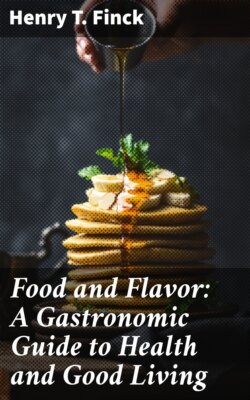Читать книгу Food and Flavor: A Gastronomic Guide to Health and Good Living - Henry T. Finck - Страница 30
На сайте Литреса книга снята с продажи.
WHY DO WE EAT POULTRY?
ОглавлениеTable of Contents
After the appearance, in "The Century Magazine" of November, 1911, of my article on Ungastronomic America, in which I denounced the practice of offering the public undrawn, cold-storage poultry, I was bombarded with abusive letters from packers and others, and a periodical, called "The Steward," fancied that it had completely demolished me by quoting the results obtained by Dr. Mary E. Pennington, in collaboration with Evelyn Witmer and H. C. Pierce, during a series of observations described in a circular entitled "The Comparative Rate of Decomposition in Drawn and Undrawn Market Poultry" published in 1911 by the Department of Agriculture. This result of these observations was that "undrawn poultry decomposes more slowly than does poultry which has been either wholly or partially eviscerated."
This statement does not agree with the conclusion reached and printed in the Bulletin No. 144 to which I have already referred, that "under precisely the same conditions of temperature and humidity, drawn fowls will keep from twenty to thirty days longer than those not drawn."
This statement is doubtless correct—provided the fowls have been eviscerated in such a way as to keep the cavity absolutely free from contamination. If this is not done, the drawn fowl will, for obvious reasons, spoil even sooner than the undrawn. It is not usually done by the American packers; and the moral is, not that undrawn fowl is preferable to drawn fowl for packing, but that these packers should send their men to France or Germany to learn how properly to draw fowls.
The consumer, anyway, is not interested in "keeping qualities." What he wants is chicken that is good to eat, and the shorter a time it has been kept, the better for him, in every way.
Dr. Wiley refers to experiments which have "shown the advisability of packing drawn poultry in tin cartons, carefully closed"; adding that "fowls thus treated preserve to a remarkable degree their freshness and palatability."
If that degree of freshness and palatibilty is sufficient to satisfy the consumer, then cold storage has a future. If not, cold storage is doomed, for undrawn, frozen poultry will, I feel sure, not be eaten much longer by the American public.
Why do we eat poultry, anyway? Surely not merely because we want food. If that were the case, why waste money on expensive chicken or turkey, when we could get the same amount of nourishment from many other foods at a mere fraction of the cost? The reason why we eat chicken in preference to those other foods is that we want to enjoy its flavor. And we do not want frozen, undrawn poultry, not only because the freezing spoils the flavor but because the leaving of the entrails in the animal makes it unwholesome.
One of the main arguments of the packers in favor of leaving fowls undrawn is that they dry out sooner when drawn. A more deadly boomerang it would be difficult to throw. There is only one way in which the drying carcass of a fowl can get its moisture: from the contents of the entrails. That is what is meant by osmosis. Thus out of their own mouths the packers stand convicted of offering the public fowl which is disgustingly tainted.
The best part of the fowl—the second joint—gets the taint soonest, because it lies nearest the intestines. The wings and drumsticks get it last. It is important to know this, because it explains why experts may differ as to the time it takes to spoil the flavor of a stored bird. Usually the process is quite rapid.
The whole question of the tainting of meat by osmosis deserves much more attention than it has received. A wild boar has to be eviscerated at once after being killed. If this is not done, none of the meat is fit to eat except the head—which explains why "wild boar's head," and the head alone—often figures on bills of fare in France and Germany. My wife, who was brought up in Southern France knew a wealthy silk merchant, a great hunter in his own domains, who always promptly removed the entrails of the boars he killed, before the carcass grew cold, the consequence being that all the meat was good to eat, as his friends were given many a chance to find out.
For several years some of the New York butchers have indulged in the custom of exhibiting in their windows the carcasses of lambs with their pelts still on. If a Paris butcher did that, the first of his customers coming along would ask him if he didn't know that unless the pelt is taken off at once after killing a mouton, the meat gets from it a disagreeable "sheepy" flavor—which is a very different thing from the unique and delicious flavor properly dressed mutton has.
Perhaps the most striking illustration of the rapid action of osmosis is provided by venison, which is unfit to eat if the deer has been tortured by a cruel chase. Its terror affects the digestive juices, and the whole body becomes tainted.
